Healthy takeaway: 8 of the healthiest options, ranked
We've asked the experts to rate eight healthy takeaway options. Here's their verdict...
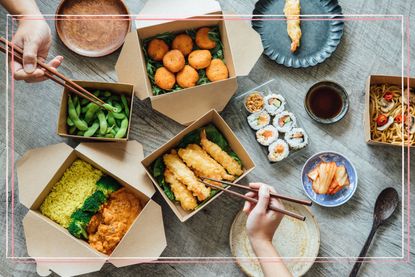

Choosing a healthy takeaway option can be hard. Most takeaway foods are high in fat and salt, so they aren't always the best option for those trying to make healthier choices with their diet.
There are a number of different ways you can opt for a healthy takeaway over the more indulgent options - and choosing to make a homemade takeaway is probably the best one. However, all families encounter times when cooking from scratch just isn't an option - you might be waiting on your next supermarket delivery, perhaps you've got back late from a day trip and need something quick and easy, or just fancy a treat at the end of a hectic week.
And if you're trying to make healthier choices when it comes to your diet - such as opting for healthier fast food and low-calorie meals - some takeaway options are better for you than others. Nutritional Therapist Hannah Braye says; “In general, takeaways should be seen as an enjoyable treat to be eaten occasionally. The simplest way to make any kind of takeaway more healthy is to eat more vegetables and salads alongside it. This will help fill you up and increase the nutrient content.”
With this in mind, we've taken a look at some of the most popular takeaway options out there, and ranked them according to their nutritional value.
Healthiest takeaway options
1. Sushi

- Tesco Salmon & Tuna Sushi: 218 calories | 4.4g fat
- Istu veggie sushi collection: 527 calories | 23.7g fat
- Asda Chosen by You Sushi selection: 252 calories | 6.7g fat
- Yo Sushi Salmon Maki: 189 calories | 4.4g fat
How to make it healthier: Hannah comments; "Sushi has a number of potential health benefits, for example, it is high in oily fish such as salmon and fresh tuna, which provide anti-inflammatory omega 3 fatty acids and traditionally fermented tofu. It also contains seaweed, which is a source of micronutrients such as iodine, which is fundamental for thyroid health, and hard to derive from other sources in the diet."
However, she adds, "Sushi is high in simple carbohydrates from the white rice, which is easily converted to sugars in the body. The liberal use of soy sauce also makes sushi very high in salt, so potentially not a good option for those with high blood pressure. In addition, there are some risks from eating raw fish (such as parasites, bacterial contaminants, and accumulation of environmental pollutants e.g. heavy metals such as mercury) so it is generally advised that sushi be avoided in pregnancy and by those with weakened immune systems."
She advises, "One way to increase the nutritional content of your meal is to just have sushi as one smaller part of your meal, and order other fish, vegetable, and seaweed-based dishes alongside it. Miso soup is a good low calorie but delicious option."
GoodtoKnow Newsletter
Parenting advice, hot topics, best buys and family finance tips delivered straight to your inbox.
- Or, try making your own at home with this avocado and prawn sushi rolls recipe
2. Burritos

- Medium wrap: 195 calories | 3.2g fat
- Mexican rice: 179 calories | 0.6g fat
- Black beans: 99 calories | 1g fat
- Chicken filling: 117.4 calories | 2.2g fat
- Guacamole: 95.4 calories | 9.4g fat
- Sour cream: 69.7 calories | 6.5g fat
How to make it healthier: "Individually, many of the components of burritos, such as beans, vegetables, shredded lettuce, guacamole, and salsa can form part of a healthy diet," says Hannah.
"Often the issue with burritos is portion control, and high-fat extras such as sour cream and cheese, which add to calorie content. When you are ordering, think about opting for veggie options full of beans (which are high in fibre and proteins) and contain more vegetables. Also have a think about whether your eyes are going to be too big for your belly, and whether sharing a burrito or keeping half in the fridge for the next day would be sensible."
- Or, try making your own at home with this chicken burrito recipe
3. Kebab
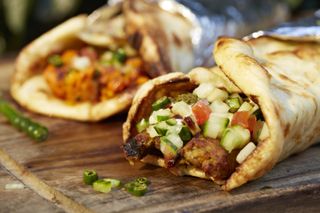
- Doner kebab (small with pitta, sauce, and salad): 570 calories | 36.8g fat
- Chicken kebab (small with pitta, sauce, and salad): 385 calories | 14.7g fat
- Shish kebab (small with pitta, sauce, and salad): 343 calories | 9.4g
How to make it healthier: Nutritional Therapist Hannah says; "Doner meat tends to be much higher in fat (around 15.5g/100g) compared to chicken kebabs (5.6g/100g) and shish kebab (4g/100g). Doner kebabs are also higher in salt and sugar. Therefore, it’s best to opt for a chicken or shish kebab when available.
"To make sure your kebab is the healthiest takeaway option, skip the side portion of chips and instead opt for a colourful Turkish or middle eastern salad. Often there are lots of varieties on offer, making eating a rainbow of colours (to obtain a range of phytonutrients) easy."
- Or, try making your own at home with this lamb kebabs recipe
4. Chinese
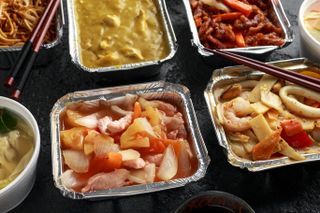
- Small egg fried rice: 679 calories | 17.9g fat
- Sweet and sour chicken: 435 calories | 6.1g fat
- Crispy duck and three pancakes: 403 calories | 21.8g fat
- Crispy chilli beef: 380 calories | 19g fat
- Chicken chow mein: 361 calories | 8.3g fat
- Prawn toast: 52 calories | 4.4g fat
How to make it healthier: Registered dietician nutritionist Steph Magill advises, "Chinese food can be low in fat and rich in vegetables, but it can also be high in salt, sugar and oil. A typical Chinese dish can have around 500 calories and 15 grams of fat. To make it healthier, choose a stir-fry with lean meat, seafood or tofu and plenty of vegetables, ask for steamed brown rice instead of fried rice or noodles, and avoid dishes that are deep-fried or have sweet or creamy sauces."
- Or, try making your own at home with this Slimming World sweet and sour chicken recipe
5. Indian
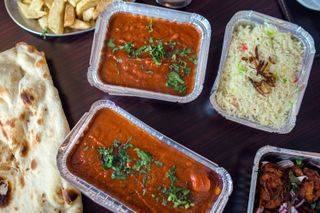
- Lamb rogan josh: 525 calories | 30.5g fat
- Chicken korma: 432 calories | 26.8g fat
- Chicken tikka masala: 384 calories | 24g fat
- King prawn balti: 277 calories | 20g fat
- Poppadom: 35 calories | 1.5g fat
How to make it healthier: Hannah advises, "Opting for vegetarian options may help to reduce energy intake. As well as avoiding filling up on naan bread, poppadums, and white rice, which are high in simple carbohydrates and provide lots of empty calories.
"Skipping the sundries such as onion bhaji and pakora will also help to reduce fat content. A healthier alternative would be to make or buy ones that can be baked in the oven at home rather than deep-fried. You could also cook your own wholegrain rice. Saag paneer and saag aloo dishes are spinach-based, so good options to increase your intake of nutrients such as folate, iron, and magnesium."
- Or, try making your own at home with this pork curry recipe
6. Fish and chips

- Battered cod: 444 calories | 28g fat
- Battered sausage: 380 calories | 30g fat
- Medium chips: 788 calories | 30.9g fat
- Small chips: 606 calories | 23.8g fat
- Fishcake: 186 calories | 9.3g fat
- Mushy peas: 98 calories | 0.4g fat
How to make it healthier: Steph Magill says, "This is a high-calorie and high-fat option, especially if the fish is battered and the chips are deep-fried. A typical portion of fish and chips can provide over 1000 calories and 60 grams of fat. To make it healthier, choose grilled or baked fish instead of battered, ask for a smaller portion of chips or share with someone and add some salad or vegetables on the side."
- Or, try making your own at home with this oven baked fish and chips recipe
7. Burger and chips
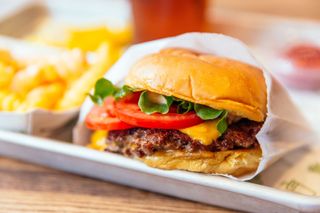
- McDonald's Big Mac: 493 calories | 24g fat
- McDonald's Vegetable Deluxe: 361 calories | 1.2g fat
- KFC Zinger Burger: 420 calories | 17.6 fat
- Nando's grilled chicken burger: 443 | 8.9g fat
How to make it healthier: Steph says, "This is another high-calorie and high-fat option, especially if the burger is large and has cheese, bacon, or mayonnaise. A typical burger and chips can provide around 1000 calories and 50 grams of fat. To make it healthier, you can choose a smaller burger with lean meat or a veggie patty, ask for whole wheat buns white, add some lettuce, veggies or tomato to your burger and swap chips for a side salad or baked potato."
- Or, try making your own at home with this Slimming World burger and chips recipe
8. Pizza
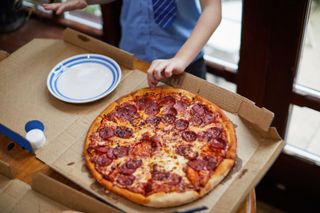
- Domino's Original Cheese & Tomato (medium): 1614 calories | 60.2g fat
- Domino's Vegi Classic (medium): 1474 calories | 48g fat
- Pizza Hut Margherita (9"): 1014 calories | 44.4g
- Pizza Hut Veggie (9"): 972 calories | 37.8g
How to make it healthier: "If having a pizza, opt for outlets that offer freshly made, rather than frozen or processed versions often sold at fast food outlets," says Hannah. "Avoid stuffed crust and instead opt for a thin crust and consider sharing a pizza and making up a big colourful salad or bowl of green veg to fill the rest of your plate."
She continues; "Also be mindful about toppings – resist the temptation of adding extra cheese and cured processed meats (which have been associated with more negative effects on bowel health, such as the increased risk of bowel cancer).
"Vegetable-based toppings such as artichoke, asparagus, and spinach will help increase the fibre and nutrient content. Avoid ordering additional carbohydrates such as chips or fries to go with it. Many pizza restaurants also now offer vegan options, without meat and cheese toppings, therefore likely reducing saturated fat content."
- Or, try making your own at home with this healthy pizza recipe
What is the healthiest takeaway option?
The healthiest takeaway on our list is sushi, because it has the added benefits of omega-3 fatty acids and vitamins such as D and B2 from the fish. Eating fish is thought to lower the risk of heart failure, according to a study in the Clinical Nutrition Journal, among other health benefits.
Nutritionist dietician Steph Magill says, "Sushi can be a low-calorie and low-fat option that provides carbohydrates, protein, omega-3 fatty acids, and vitamins. A typical sushi roll can have around 200 calories and 5 grams of fat. To make it healthier, choose brown rice instead of white rice, opt for fish or vegetable fillings instead of tempura or mayonnaise, and limit the amount of soy sauce."
Meanwhile, nutritional therapist Hannah Braye explains how you can make sure you are choosing a healthy takeaway, whichever cuisine you prefer. "The healthiest takeaway options are from restaurants which cook from scratch using fresh ingredients, and include lots of vegetables in their dishes, rather than fast food options. Thai food is often a good shout if you opt for items such as green papaya salad, tom yam soup, and Thai curries."
She continues; "You could also consider cooking your own accompaniments such as wholegrain rice, baked sweet potato fries, and extra veggies or salads."
How to cut fat and calories in a takeaway
Avoiding deep-fried items, reducing the amount of simple and refined carbohydrates (such as chips, white rice, and bread) and thinking about portion control can all be ways to have a healthier takeaway.
Ordering excess amounts of food can tempt people to overeat, so consider reducing your order or leaving certain more unhealthy items off your order completely.
Registered nutritionist Steph Magill offers the following tips to help make healthier choices when ordering a takeaway:
- Choose meals that are about ⅓ of your daily calorie needs - this should be around 600 calories for a diet based on the 2000 calorie diet
- Choose dishes that are grilled, baked, steamed, or stir-fried instead of fried, battered, or crumbed
- Opt for dishes that have lean meat, seafood, tofu, or beans instead of fatty meat, cheese or cream
- Make sure you're choosing dishes that have plenty of vegetables, whole grains, salad or fruit
- Choose sauces that are tomato-based, instead of creamy, cheesy or sweet
- Ask for the sauce or dressing on the side
- Order a smaller portion, save half for another meal or share with someone
- Drink water or low-calorie drinks such as flavoured water instead of soft drinks, alcohol or juice
If you're looking for more ways to make healthier choices while still allowing yourself a treat once in a while, we've ranked the healthiest chocolate bars, healthiest biscuits, and the best and worst crisps for your diet.

Jessica Dady is Food Editor at GoodtoKnow and has over 11 years of experience as a digital editor, specialising in all things food, recipes, and SEO. From the must-buy seasonal food hampers and advent calendars for Christmas to the family-friendly air fryers that’ll make dinner time a breeze, Jessica loves trying and testing various food products to find the best of the best for the busy parents among us. Over the years of working with GoodtoKnow, Jessica has had the privilege of working alongside Future’s Test Kitchen to create exclusive videos - as well as writing, testing, and shooting her own recipes. When she’s not embracing the great outdoors with her family at the weekends, Jessica enjoys baking up a storm in the kitchen with her favourite bakes being chocolate chip cookies, cupcakes, and a tray of gooey chocolate brownies.
- Ellie HutchingsFamily News Editor
-
 Think you're raising a mini-me? It's actually unlikely your child will inherit your personality and could have a temperament closer to a 'random stranger', according to new study
Think you're raising a mini-me? It's actually unlikely your child will inherit your personality and could have a temperament closer to a 'random stranger', according to new studyIf you often hear the phrase 'like mother like daughter,' or 'like father like son,' research suggests you're actually only slightly more likely to share familial traits than with strangers.
By Lucy Wigley Published
-
 30 Bluey baby names: Would you name your little one Calypso, Honey or Coco?
30 Bluey baby names: Would you name your little one Calypso, Honey or Coco?These Bluey baby names for boys and girls are unusual choices, but could be perfect for fans of the children's cartoon.
By Ellie Hutchings Published